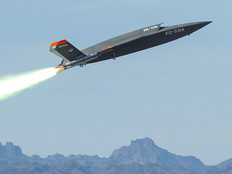DoDIIS 2019: Defense Intelligence Agency Looks to MARS to Analyze Data
The Defense Intelligence Agency plans to begin work in earnest next year on its Machine-Assisted Analytic Rapid-Repository System (MARS), a groundbreaking way to analyze large amounts of data in nearly real time.
“2019 was about learning. This was a year of prepping to get started,” said Terry Busch, MARS program manager, at the 2019 DoDIIS Worldwide Conference in Tampa, Fla., Monday. “In 2020, we start.”
The agency will hold a MARS Industry Day event Sept. 10 in McLean, Va., to update potential contractors on the program’s status; top DIA officials “want this to be a strong industry partnership,” Busch said.
MARS is one of the agency’s top priorities in its recently released Chief Information Office strategy for 2020 through 2024, according to Army Lt. Gen. Robert P. Ashley Jr., the DIA’s director.
“Large, complex data sets don’t talk to one another, and we’ve got to fix that,” he said. MARS “is the scouting report for the team we’re going to play, and we’re going to update it every day.”
Multiple Databases Mean Less Efficient Collaboration
Currently, general military intelligence data gets to the service members in the field through dozens of systems, including the primary military intelligence database, the Modernized Integrated Database (MIDB), now about 20 years old.
As reliable as that system has been, however, it doesn’t allow multiple partners to work simultaneously on one problem, as services might have to do in the heat of battle, said Mac Townsend, a defense intelligence senior-level officer at DIA.
“The intent with MARS is to do some data synchronization in a way that’s as innovative as we can get,” he said. “We’re looking to industry to help us synchronize our data across multiple regions and multiple domains.”
MARS will differ from MIDB and other databases in that it will not be just a receptacle for data. Because it springs from developments in cloud computing, artificial intelligence and machine learning, it will have capabilities far beyond those of current databases, Busch said.
For instance, MARS is expected to be able to create a virtual model of an enemy environment, and planners should be able to run quick simulations before sending orders to troops.
“What comes out of MARS at the end is not data, it’s analysis. It’s finished intelligence,” he said.
MORE FROM FEDTECH: See how DOD and the State Department plan to shift operations to the cloud.
DIA Plans to Run Two Database Systems at Once
The excitement over MARS does not mean an end to MIDB, however. That database is funded for the next five years. “We’re not looking to take that away,” Townsend said.
DIA plans to run both MARS and MIDB simultaneously for a while as the legacy database is transferred to the new model, he said.
“Both systems have to coexist until we’ve transitioned all of our legacy partners off,” Busch said. “Eighty percent of our programs can drink from this new fountain. Those who cannot, we will slowly begin to move them over. We’ll have to support those older databases for a long time.
“That is a years and years process,” he added. “We cannot do this another way. There is no turning MIDB off.”
For more articles from DoDIIS 2019, check out our conference coverage here.




_0.jpg)
.png)



